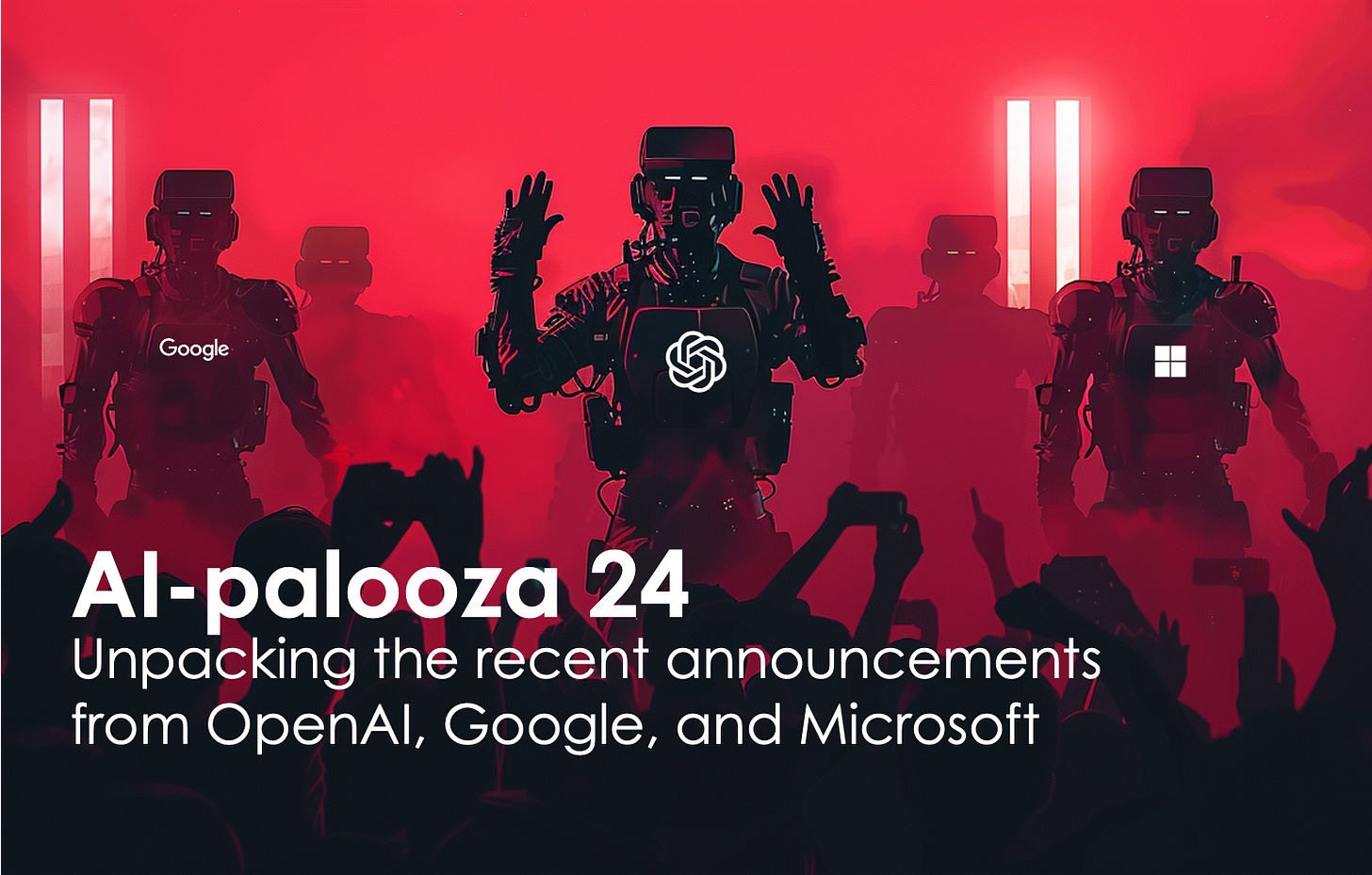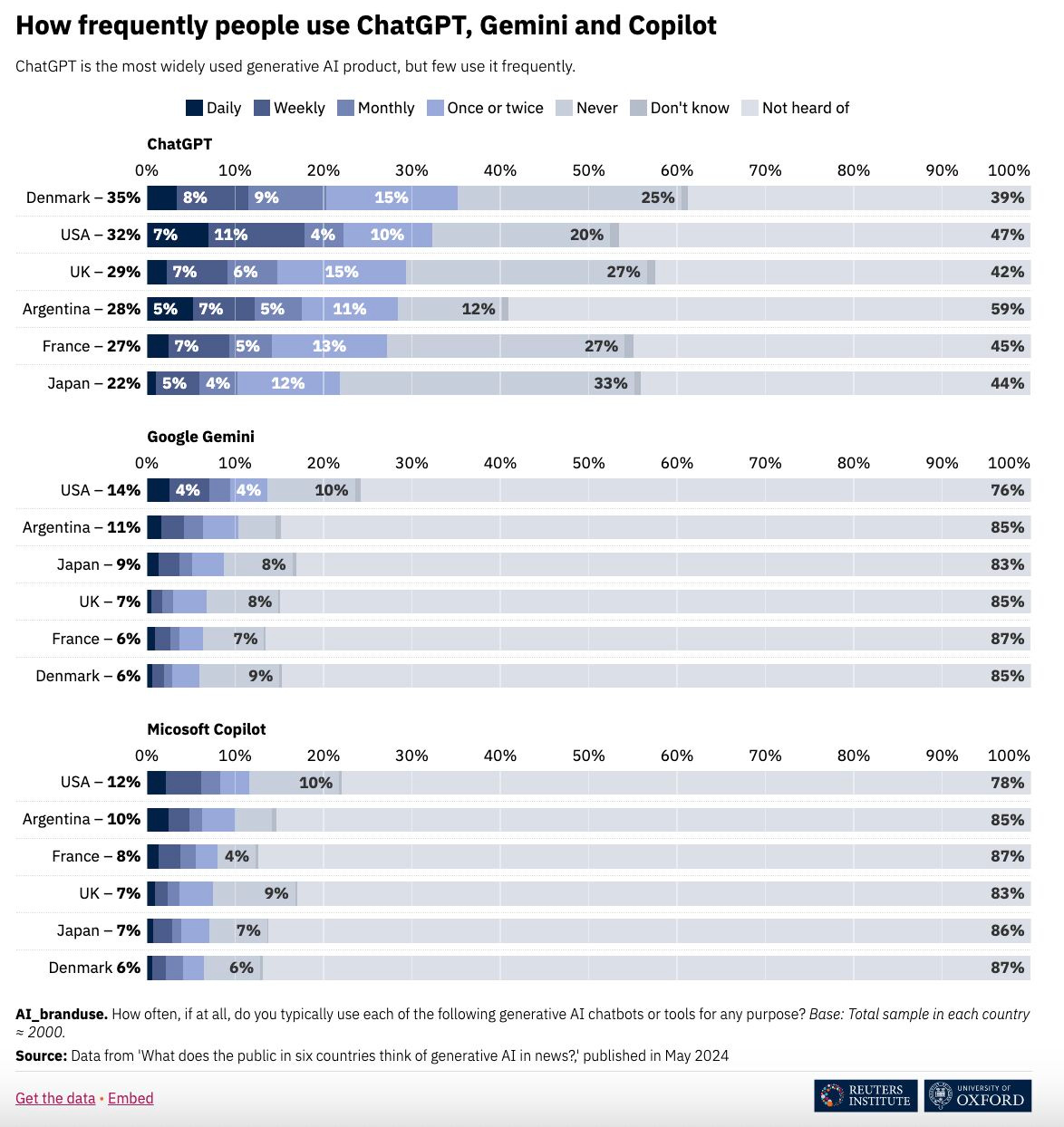Welcome back to the Brand Next newsletter.
For those of you that are new, this newsletter explores how new technologies are changing marketing and human behaviour. We help you understand how to benefit from these changes by spotlighting the people, technologies, and use cases that put strategy into action and drive valuable business results.
If you are reading this and haven’t yet subscribed, please do. It’s a great place to keep up with the changes that are impacting us today, and which will impact us tomorrow. 🚀
You can also subscribe to the Brand Next Podcast on Spotify, Apple Podcasts, or YouTube.
It’s been a few weeks of big AI announcements, and while that is hardly a remarkable statement given how fast the industry is moving and how much comes out every week, the past few weeks have been even busier than usual. Some of it was expected. As we approached Google I/O and Microsoft Build we knew that AI was going to take center stage for both. But before the party could start, OpenAI rushed in to make a few announcements of their own.
In this post, we look at the biggest announcements from each of them and outline how their strategies appear to differ and outline a few business, marketing, and customer experience use cases that you can test to familiarize yourself with the new capabilities. We also highlight a few fun things to try today.
OpenAI: Democratizing Advanced AI
ChatGPT is the fastest growing app of all time. That said, user growth has slowed, and despite the impressive speed of growth, their total user numbers are still dwarfed by both Microsoft’s install base and the number of daily users of Google Search.
Microsoft Office 365's share of the productivity software market was ~48% and Microsoft products are installed in over 70% of Fortune 500 companies
Google has ~90% of the search market with over 80% of people saying they use it for search multiple times per day.
The risk is therefore that despite having a AI capability leadership, OpenAI’s advantage will slowly disappear as these giants capabilities catch up and their default stance in other areas carries over to AI usage.
To combat this risk, it would appear that OpenAI are focused on growing user penetration by making their AI tools easier to use and providing everyday users with both a better experience and better results. This isn’t just a race to improve the model (although that is happening), for OpenAI it’s a race to become as ubiquitous with everyday AI use as Google is for everyday search.
The good news is that the advancements required to make for a better experience, such as multi-modal inputs and access also offer significant benefit to both power users and enterprise clients.
Highlights of what they announced
Introducing of GPT-4o: The o stands for Omni-Modal meaning that this latest flagship model promises not only enhanced speed and performance, but this new model also excels in voice, and vision tasks, setting a new standard for AI capabilities.
To highlight the benefits of this for everyday people, OpenAi created a lot of videos showing how onmi-modal interaction unlock new use cases to facilitate everyday tasks like education. Additionally, they changed their pricing strategy by giving FREE users access to the latest GPT-4o model. The benefit for ChatGPT Plus users is access to the API along with 5x the capacity of FREE users.
They also showed how Businesses can now leverage these advanced features to provide more responsive and intuitive customer interactions, and do so at a lower cost than the previous version of GPT-4turbo
Advanced Tools and Accessibility in more detail: In line with its mission to make advanced AI accessible to everyone, OpenAI is also rolling out more sophisticated tools including:
Data Analysis and Chart Creation: Empowering users to analyze data and create visual representations seamlessly.
File Uploads: Assisting in summarizing, writing, or analyzing uploaded documents.
Language Support: Enhancements that support over 50 languages, making it easier for global businesses to integrate AI into their operations.
Desktop app for macOS: This app integrates ChatGPT into daily workflows, allowing users to take and discuss screenshots, have voice conversations, and utilize a more conversational interface. These features are designed to streamline tasks and improve productivity.
One fun way to explore the new capabilities if you’re looking to test out omni-modal voice in your daily life would be to turn your car into a classroom for your kids. I turn it on and let them ask questions about science and history. With a few simple guidelines on how to answer it has become a great tutor that continuously fuels their curiosity and desire to ask more questions.
Google: Integrating AI Across the Ecosystem
Unlike OpenAI, Google doesn’t need to grow penetration, they need to defend it - especially as it relates to search. To do this, they are building systems to connect all your data sets and integrate AI into every one of the touchpoints you already use so you have no reason to go elsewhere. Their strategy appears to be a focus on everyday interaction and use cases.
At the same time, they are still playing catch-up on capability and quality and so wanted to demonstrate a more powerful model.
Highlights of what they announced
Gemini AI Models: Google's announcements at I/O 2024 were headlined by the Gemini 1.5 models, which boast huge context windows of up to a million tokens, with comments hinting at even larger limits along with dramatically improved performance. These models are integrated into various Google tools, including Search, Workspace, and Android, enhancing their capabilities significantly.
Project Astra: Developed by Google Deepmind, Astra is a new multimodal AI agent, capable of answering real-time questions, fed to it through text, video, and images and speech. The video demo is very impressive as it reacts to real time images and demonstrates memory and awareness of everything it sees.
Generative AI Tools: Google introduced several new generative AI tools that businesses can leverage for creative and operational benefits:
Imagen 3: The highest-quality image generation model yet, capable of understanding complex prompts and generating photorealistic images. See it here.
Veo: A video generation model that can create high-quality 1080p videos in various styles. Check it out here.
Music AI Sandbox: Tools for creating new music, transferring styles, and collaborating with artists.
AI Integration in Daily Life: Google is integrating AI into its suite of products to enhance user productivity and creativity:
Gemini Advanced: Features for data analysis, trip planning, and conversational experiences.
Workspace and Photos Integration: Using AI to summarize emails, create itineraries, and recall specific memories or information.
While much of what the announced is yet to be released and so can’t be played with, one thing you can see today is search so go on and give it a try. And yes, it does give you some funny / wrong answers sometimes, but the progress they are making with this is impressive.
Microsoft: Enterprise Integration and Developer Tools
Microsoft's focus was on enterprise integration and enhancing developer tools and building into their existing enterprise install base. This isn’t a huge surprise given that Build is their developer conference. What they demonstrated was how through AI copilots and real-time data intelligence, they could help to automate and optimize business processes. This approach seemed to be geared mostly to large enterprises looking to scale their AI efforts and integrate AI deeply into their operations.
At the same time, they made announcements about developing their own foundation model in order to reduce their reliance on OpenAI. In this way Microsoft is ensuring that compatibility for their business clients regardless of what AI model they want to use.
Highlights of what they announced
Copilot: Copilot(s) remain at the heart of Microsoft’s strategy, but the integration and toolset to develop and leverage copilots is getting a lot more powerful. Copilot Studio offers new set of features that enable the creation of AI copilots, integrating line-of-business data directly into copilot experiences.
Beyond this, Microsoft announced Copilot + PC which represents a deeper integration between hardware, operating system and AI. So much so that the machines can capture and see everything you do on screen to be able to support actions based on what you are seeing.
Other AI-Powered Tools: Key AI-powered tools introduced by Microsoft include:
GitHub Copilot Extensions: Allowing developers to build and deploy in the cloud using natural language.
New Virtual Machines and AI Infrastructure: Including the ND MI300X V5 and Azure Cobalt, designed for high-performance AI workloads.
Responsible AI and Security: Microsoft continues to lead in responsible AI practices with new features like Prompt Shields and Groundedness Detection, which help ensure the safe and responsible use of AI. These enhancements are crucial for businesses looking to deploy AI solutions while maintaining high standards of security and ethics.
A few enhanced use cases for businesses
Automated Business Processes: Using Copilot Studio to create AI copilots that automate routine tasks and integrate with business data.
Real-Time Data Intelligence: Implementing real-time intelligence features in Microsoft Fabric to act on large volumes of data quickly.
Developer Tools: Enhancing development workflows with GitHub Copilot and new virtual machines, enabling faster and more efficient AI deployments.
What it all means
These announcements from OpenAI, Google, and Microsoft are a testament to the speed of development around AI technologies and use cases. In each case, these business are racing to develop not only new and distinctive capabilities, but also capture audience and users as the look for leadership in this growing space.
If anyone is going win the race in the way that Google won search remains to be seen, but the level of integration they are all enabling between AI capabilities and everyday use cases indicates that one way or another, AI integrations is software and hardware will soon be as ubiquitous as electricity is in the home. In the long-run this won’t be about getting consumers to explicitly choose your AI service, but about seemlessly integrating AI tools into the services that people use everyday so they don’t have to even think about the provider.
In business on the other hand, where deliberate consideration and procurement is required, the question of where large models will be best suited, and where small or industry optimized models will dominate remains outstanding. Costs and access to compute can still be a challenge, but the landscape is quickly changing here with OpenAI continuing to aggressively reduce prices.
As a marketer, the developments present exciting opportunities to enhance customer engagement, streamline operations, and drive innovation. But despite all the talk, capturing the value potential isn’t easy and will require not only experimentation to see where efficiencies can be created, but also significant focus on culture as change and adoption are already seen to be challenging (more on this soon). And marketers should also get ready for the next wave of AI announcements which will likely come from the Marketing Agency Holding Companies during the Cannes Lions Festival of Creativity in mid June.
Other notable announcements include
While many of us live in world where AI seems all consuming, AI usage and penetration varies significantly. Here is some great research on the subject from reuters and Oxford.
Elon Musk’s company xAI raises $6 Billion at a $24 billion dollar valueation in their question to challenge OpenAI.
Canva launches a range of new AI features and Enterprise design and workflow tools including: Magic Media, Magic Write, Magic Design, Magic Switch, and new Video Editing Capabilities.
Anthropic published research on how to see into the black box that is AI in order to see how it works and how it thinks.
Meta is working on a paid version of their AI Assistant
TikTok has launched Symphony as a new tools that brands can use to create AI driven social campaigns
But the big question is … what will Apple do? Their World Wide Developer Conference (WWDC) is scheduled for June 10th, and the rumor is that they will announce a partnership with OpenAI - potentially to help power the next generation of Siri. But what else will they announce? How else will AI integrate with iPhone and with their devices. They like to have a few surprises up their sleeve so only time will tell, but at least the wait won’t be long.
If you enjoy the Newsletter and want to get more, please subscribe
If you already subscribe but want to do more to help grow our readership, you can share the article with your friends. One share from you makes a world of difference to me.
If you want more content from Brand N3xt, you can also subscribe to the Podcast or follow and connect with me on social channels through the links below:
Subscribe to the Podcast on Spotify, Apple Podcasts, or even on YouTube
Follow me on X at @justinkpeyton
Follow me on LinkedIn










